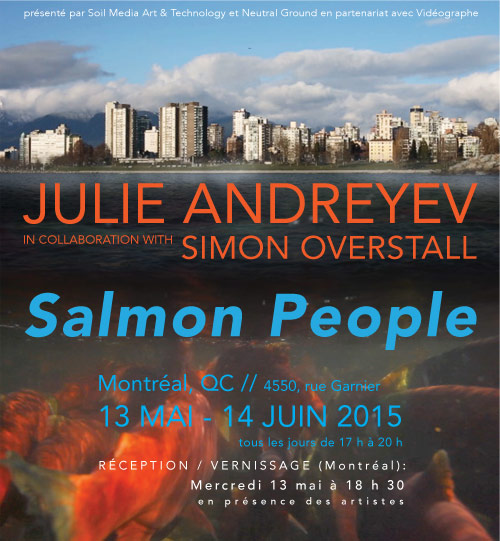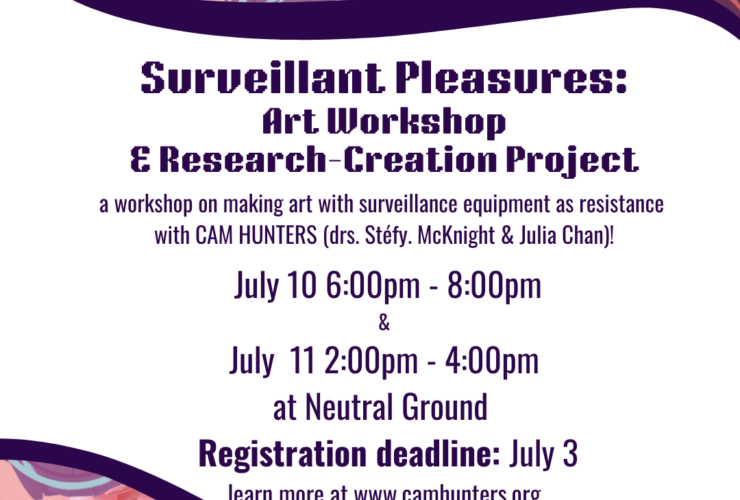Julie Andreyev + Simon Lysander Overstall
May 13 – June 14, 2015
Presented by SOIL Media Art & Technology and Neutral Ground in partnership with Videographe.
RECEPTION (Montreal):
4550, rue Garnier
Wednesday, May 13th, 6:30 p.m., artists in attendance.
RECEPTION / VERNISSAGE (Montreal):
4550, rue Garnier
Mercredi 13 mai 18 h 30, en presence des artistes
English | Franais | Artist Bios
English
SALMON PEOPLE
Salmon People, generative audio video installation, 2014
Salmon People is a depiction of the intertwined worlds of humans and other animals. The project presents the salmons below-water point of view, combined with footage of the cityscape of Vancouver and surrounding waters. The soundscape, made up of recorded and synthesized sounds, alludes to a familiar yet strange other-world.
Salmon People depicts the survivors of the salmon cycle of life. After birth, most salmon die or are killed through a number of causes: natural predators eat them; logging disrupts their natural habitat; irrigation ditches confuse them; undissolved human sewage poisons them; turbine intakes at dams shred them; nitrogen-rich water on the downstream side of dams suffocates them; waste from pulp mills and chemical plants toxify them; warm and oxygen-depleted water created by industry asphyxiates them; fish farms put parasites, antibiotics and hormones in their way. The survivors, depicted here, swam for 3-4 years in the northern pacific, making a counterclockwise circular migration around the ocean. Once they decide to spawn they then traveled 40 to 90 miles a day to their spawning grounds. Salmon find their way back to their birthplace as individuals not as schools, and they find their particular birth-stream using scent-mind.
Salmon People recalls a story from the local First Nations Tsleil-Waututh (The People of the Inlet), describing salmon as having perseverance, patience and strength. The story relates how salmon people live in villages far away under the sea and return to the rivers yearly to visit the humans and their villages, where they are treated well.
In Salmon People, the project is programmed to be generative. The custom software determines the visual arrangement and soundscape generated from an archive of video and sound clips. The resulting depiction is a constant combining and recombining into sea-land-scapea reminder of the shared ecologies of salmon and humans.
Production Team:
concept and editing: Julie Andreyev
custom software and sound design: Simon Lysander Overstall
salmon cinematographers: Elisa Ferrari, Paolo Pennuti
city cinematographer: Amanda Arcuri
Francais
SALMON PEOPLE
Salmon People, installation audio-visuelle generative, 2014
Salmon People est une representation des espaces interrelies entre humains et autres animaux. Le projet utilise une camera submersible pour presenter le point de vue subaquatique du saumon en conjonction avec des sequences video du paysage urbain de Vancouver et des eaux qui l’entourent. La bande sonore, composee tant de sons enregistres que synthetiques, fait reference et un autre-monde la fois familier et etrange.
Salmon People represente les survivants du cycle de vie du saumon. Apres la naissance, la plupart des saumons meurent ou sont tues par nombre de causes : des prdateurs naturels les mangent ; l’exploitation forestire perturbe leur habitat naturel; les fosss d’irrigation les perturbent ; les matires humaines non dissoutes des eaux uses les empoisonnent; les turbines des barrages les broient ; les eaux riches en azote en aval des barrages les suffoquent ; les dchets des usines pte et chimiques les intoxiquent ; les eaux chaudes et appauvries en oxygne rsultant de l’industrie les asphyxient ; les piscicultures les mettent en contact avec des parasites, des antibiotiques et des hormones. Les survivants, reprsents ici, ont nag pendant 3-4 ans dans le Pacifique Nord, effectuant une migration circulaire en sens inverse des aiguilles d’une montre autour de l’ocan. Lorsqu’ils dcident de se reproduire, ils voyagent alors de 40 90 milles par jour jusqu’ leur lieu de naissance pour pondre. Les saumons retrouvent leurs lieux de naissance en tant qu’individus, et non en tant que bancs ; puisqu’ils retrouvent leur cours d’eau de naissance particulier en utilisant leur esprit olfactif.
Salmon People remmore une histoire de la Premire Nation Tsleil-Waututh (Peuple du bras de mer) dcrivant la persvrance, la patience et la force du saumon. L’histoire raconte comment les “tres saumon” vivent dans des villages lointains sous la mer et retournent tous les ans rendre visite aux humains dans leurs villages o ils sont bien traits. Dans Salmon People, les vidos et les sons sont programms pour tre gnratifs, se combinant et recombinant continuellement entre eux en de multiples et divers paysages marins/terrestres : comme une sorte de recration de relations humains/saumons.
quipe de production:
montage: Julie Andreyev
logiciel de prsentation et audio gnrative: Simon Overstall
cinmatographie de saumon: Elisa Ferrari, Paolo Pennuti
cinmatographie de ville: Amanda Arcuri
Artist Bios
Julie Andreyev is an artist, vegan, researcher and educator. Andreyevs art practice, called Animal Lover, www.animallover.ca, examines problematic human relations with other beings, and explores animal agency and creativity using modes of interspecies collaboration. The projects take the form of new media performance, video installation, generative art, app art, and relational aesthetics. The interspecies collaborations are explored using ethical modes, paying attention to the other in the process of making. In the projects with the two companion dogs Tom and Sugi (www.tomandsugi.com, twitter: @Tom_and_Sugi) respect, fun and challenge are employed in the process. The Animal Lover projects have been shown across Canada, USA, Europe, and Asia, and are supported by the Canada Council for the Arts and the Social Sciences and Humanities Research Council of Canada.
Andreyev is Associate Professor at Emily Carr University of Art + Design in Vancouver, and Artistic Director of a biannual symposium/exhibition called Interactive Futures, www.interactivefutures.ca. She is co-founder of the art group Vegan Congress, www.vegancongress.org that holds relational events intended to develop awareness and compassion towards nonhuman beings.
Andreyev is a Joseph Armand Bombardier Scholar completing her PhD research at Simon Fraser University in Vancouver. The research examines compassion as a means for improved awareness and relationships with nonhuman beings and our shared ecologies. This research is supported by the Social Sciences and Humanities Research Council of Canada.
Simon Lysander Overstall is an artist working in digital arts and new media, in particular sound and music. He has produced sound designs and compositions for dance, theatre, and installations. He develops works with generative, interactive, or performative elements. He produces interactive performance systems and art installations which have been shown in Canada, the US, Europe, and China. He has a BFA in Music Composition from the School for Contemporary Arts at Simon Fraser University, and an Associate in Music (Jazz) Diploma from Malaspina University-College. Currently, he is working on his MA in Sound in New Media at Aalto University in Helsinki.
Julie Andreyev est artiste, vgtalienne, chercheuse et ducatrice. Sa pratique artistique qu’elle appelle Animal Lover, www.animallover.ca, aborde la problmatique des relations humaines avec les autres tres, et explore le pouvoir et la crativit de l’animal “autre-qu’humain” travers diverses formes de collaboration inter-espces. Ses projets prennent la forme de performances nouveaux mdias, dinstallation vido, dart gnratif, dapp art et d’esthtique relationnelle.
Les collaborations inter-espces sont explores en utilisant des modes thiques, et en accordant une attention particulire l’autre dans le processus de fabrication. Elle travaille principalement avec ses deux chiens de compagnie Tom et Sugi (www.tomandsugi.com, twitter: @Tom_and_Sugi). Son travail a t prsent travers le Canada, aux Etats-Unis, en Europe et en Asie et a t soutenu par Le Conseil des Arts du Canada, Le Conseil des Arts de la Colombie Britannique et le Conseil de Recherches en Sciences Humaines du Canada. Elle est professeur agrge au Emily Carr University of Art + Design Vancouver et directrice artistique dInteractive Futures, www.interactivefutures.ca. Ses recherches doctorales actuelles l’Universit Simon Fraser portent sur la compassion en tant que moyen d’amlioration de la prise de conscience et des relations entre humains et non-humains dans nos cologies partages.
Simon Lysander Overstall est un artiste qui travaille dans les arts numriques et les nouveaux mdias, en particulier le son et la musique. Il a produit des conceptions sonores et des compositions pour la danse, le thtre et des installations. Il dveloppe des uvres avec des lments gnratifs, interactifs ou performatifs. Il produit des systmes de performance interactives et des installations artistiques qui ont t prsents au Canada, aux tats-Unis, en Europe et en Chine. Il a un baccalaurat en composition musicale de l’cole des arts contemporains de l’Universit Simon Fraser, et un diplme de Musicologie en Jazz de lUniversit de Malaspina. Il travaille actuellement sur une matrise en acoustique dans les nouveaux mdias l’Universit Aalto dHelsinki.


